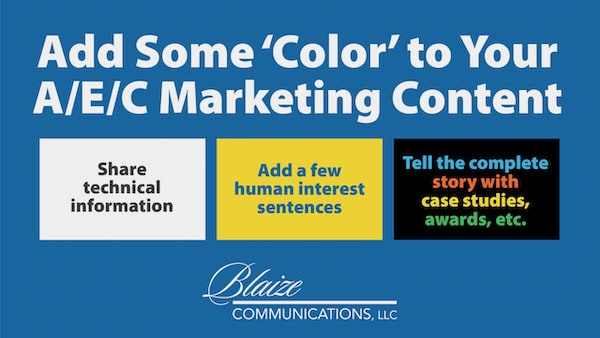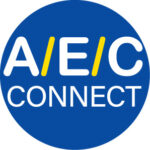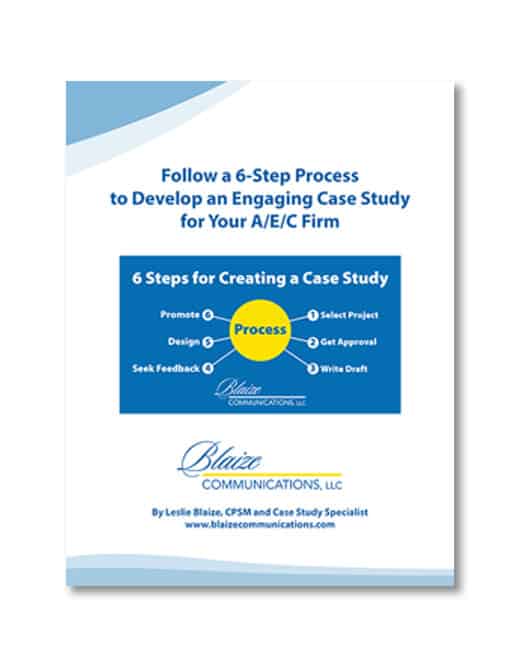How will generative AI impact the creation of proposals and other marketing collateral in the Architecture/Engineering/Construction industry?
AI’s benefits are already making a difference. It can improve efficiency, help generate ideas, and much more. But there’s a downside. Will prospects be saying, “These proposals all sound alike”?
Where’s the differentiation?
For decades, A/E/C firms have worked to demonstrate that they offer superior service and successful outcomes. It’s generally agreed that forging client relationships is the key to ongoing work. Business developers and seller-doers spend lots of time developing those relationships.
Add the Human Touch
One way to connect with prospects and existing clients is to incorporate client stories, quotes, and descriptive narratives into marketing materials. These human-interest pieces add authenticity to a firm’s brand. No one else can tell those stories. And the benefit is that these narratives create emotional connections with potential clients. They’re usually more memorable than facts and figures.
Start Small
Here’s the good news about storytelling for Architecture/Engineering/Construction firms: You can start small and build upon your progress. What’s the end goal? Add some interest to your marketing collateral.
The A/E/C world is full of fascinating stories of professionals who successfully complete projects to improve the lives of communities. But all too often, project updates focus on the technical details and don’t celebrate how these projects have made a difference. How did they impact the end user? What’s different because of these projects? What obstacles did you overcome?
Kraig Kern, CPSM, Vice President of Marketing at WK Dickson & Co., Charlotte, North Carolina, wrote an article in The Zweig Letter regarding the value of telling hero stories. Here’s an excerpt:
“… in the AEC business, we can control the narrative. We can share stories that make us feel good. Everyone loves a great hero or underdog story, right? So why don’t we write those instead of the typical, dull technical descriptions?
“Inevitably, we sometimes must write about subjects as exciting as watching water drip or paint dry. However, with a bit of time and creative thinking from your marketing team, overly technical topics can be made more exciting,” Kern says.
Project updates fill the web pages of A/E/C firms throughout the country. Many summarize the technical approach and problems solved. Some add testimonials and note how citizens benefit. More can be done to engage readers.
Check out three types of project narratives …
All Technical Information
These project updates share just the technical aspects of the projects and services provided. For purely technical audiences, there’s a place for this kind of summary. It probably won’t interest many readers who know little about the topic.
Technical Information Plus Some Storytelling
With this approach, there’s an effort to add a human dimension to the project summary for your website or proposal. Marketers or project managers can ask, “How will a project impact the end user?”
The summary might explain how the project improved the lives of the community residents, building occupants, or the traveling public. Including a testimonial would add interest and credibility to the narrative.
For example, add a few sentences about how families are enjoying a new park. Share attendance increases. You could tell a story of how a family frequently visits the park because it’s safer or offers more amenities.
How are residents enjoying a new multi-family complex? Or how has a road improvement project encouraged downtown development? Quote a new business owner who’s thrilled with the upgraded downtown.
Consider asking clients about the results of previous projects. Can they offer an updated or new testimonial?
Public officials, investors, and other stakeholders all benefit from meeting the needs of the actual users. And successful projects often translate into more work for A/E/C firms.
Combination of Storytelling and Technical Solutions
Telling the more complete story of a project requires additional effort. Input may be needed from project managers, clients, and partners. These insights could be shared in an industry award entry. Or a firm may want to create a case study that tells the project story from a happy client’s point of view.
The goal is to create an engaging narrative that can be used in multiple ways. Sharing just the technical details may not interest a broad range of readers, including website visitors, award judges, or prospects who want to know what it’s like to work for a firm. Describe how a project made a difference in the lives of an individual.
Award Submittals
For an award submittal, share your client’s thoughts about how the project achieved their goals. Perhaps a new or renovated restaurant reflects their Italian heritage, or the new wastewater treatment plant will allow the community to welcome a new industry, bringing in more jobs and tax revenue. What challenges were overcome?
Take the reader behind the scenes so they understand how your firm collaborated with the client to complete the project successfully.
Case Studies
For a case study, a firm will ask a happy client to tell their story. Readers will learn about the client’s challenges and how the A/E/C firm solved them. Results can be qualitative or quantitative. Prospects will understand what it’s like to work with a firm.
Companies can use these case studies on their website to tell the complete story. Readers could click on a link from an abbreviated project update to the case study. Quotes and metrics from the case study can be included in proposals, client presentations, and on a company’s website. A designed copy could be sent to prospects from business development staff and seller-doers. Content also could be turned into a blog post or video script.
Add Storytelling — One Step at a Time
When preparing project narratives, look for ways to make them more engaging. Perhaps this means asking the project manager more questions or reviewing a client’s website or social media posts to see how they describe the project.
Why bother? Stories engage readers, meaning they’ll spend more time reviewing your marketing collateral, whether it’s your website, award entry, or case study.
One way to differentiate your firm in the age of AI is to take a more human-centric approach to your content. Those quotes and stories will help build trust and credibility with the readers. And in the end, that’s what you’re seeking with your firm’s marketing collateral.
Have Questions?
How are you using storytelling at your firm? I invite you to share your thoughts in the comments section below. Subscribe to A/E/C Connect to learn more. If you have a challenge or question you would like me to address, post it in the comments section or contact me at blaizecommunications@gmail.com.



